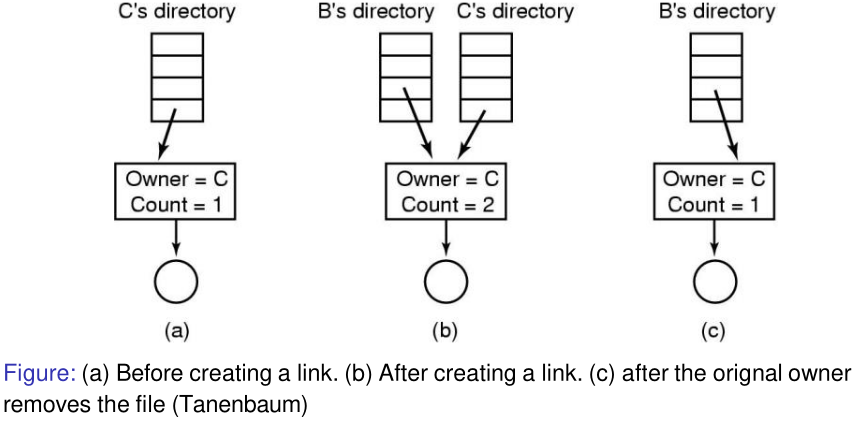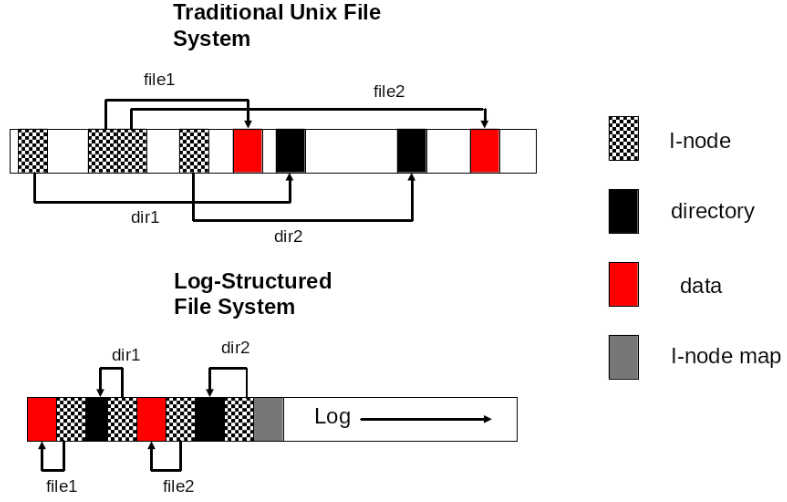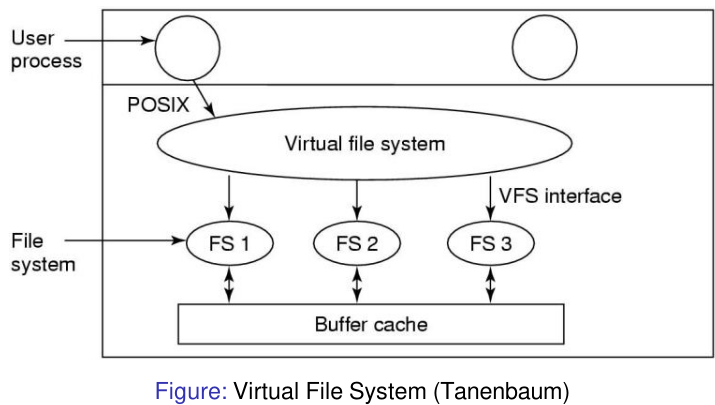21. I-Nodes & File Systems
02/12/22
I-nodes
- Two approaches to share a file
- Hard Links: Maintain two (or multiple) references to the same i-node in B and C
- Symbolic/soft links: Owner maintains a reference to the i-node. The 'referencer' maintains a small file (has its own i-node) that contains the location and name of the shared file in directory
Hard Links
Fastest way of linking files!
- Disadvantages:
- If the i-node is deleted, any hard link will point to an invalid i-node
- If the i-node gets deleted and recycled to point to an other file, the hard links will point to the wrong file!
- Only solution is to delete the file, and leave the i-node intact if the 'reference count' is larger than 0

Soft Links
- Disadvantages:
- They result in an extra file lookup (once the link file has been found, the original file needs to be found as well)
- They require an extra i-node for the link file
- Advantages:
- No problems with deleting the original file -> the file simply does not exist any more
- They can cross the boundaries of machines. Linked file can be located on a different machine
Log Structured File System
Context
Consider the creation of a new file
- Allocate, initialise and write the i-node for the file
- Update and writ the directory entry for the file
- Write the data to the disk
The corresponding blocks are not necessarily in adjacent locations!
Also in linked lists/FAT file systems blocks can be distributed all over the disk
Due to seek and rotational delays, hard disks are slow compared to other components in a computer
A log structured file system aims to improve the speed of a file system on a traditional hard disk by minimising head movements and rotational delays using the entire disk as a great big log
A log is a data structure that is written only at the end
Concept
Log structured file systems buffer read and write operations (i-nodes) in memory, enabling us to write 'larger volumes' in one go
Once the buffer is full it is 'flushed' to the disk and written as one contiguous segment and the end of a log
- I-nodes and data are all written to the same segment
- Finding -nodes (normally at the start of the partition) becomes more difficuly
An i-node map is maintained in memory to quickly find the address of i-nodes on the disk

A cleaner thread is running in the background and spends its time scanning the log circularly and compacting it.
Hard drive is treated as a circular buffer
It removes deleted files and files being used right now are marked as free segments as they will be later written at the end
Advantages
- Greatly increases disk performance on writes, file creates, deletes
- Writes are more robust as they are done as a single operation(multiple small writes are more likely to expose the file system to serious inconsistency)
Disadvantages
- Not been widely used because it is highly incompatible with existing file systems
- In addition, the cleaner thread takes additional CPU time
File System Implementations
Deleting a file consists of:
- Remove the files directory entry
- Add the files i-node to the pool of free i-nodes
- Add the files disk blocks to the free list
- Where does it go wrong:
- Directory entry has been deleted and a crash occurs -> i-nodes and disk blocks become inaccessible
- The directory entry and i-nodes have been released and a crash occurs -> disk blocks become inaccessible
- Changing the order of the events does not necessarily resolve the issues
- Journaling file systems aim at increasing the resilience of file systems against crashes by recording each update to the file system as a transaction
Concept
- Key idea behind a journaling file system is to log all events (transactions) before they take place
- Write the actions that should be undertaken to a log file
- Carry them out
- Remove/commit the entries once completed
- If a crash happens in the middle of an action the entry in the log file will remain present after the crash
- The log can be examined after the crash and used to restore the consistency of the file system
- NTFS and EXT3-4 are examples of journaling file systems
Virtual File Systems
Multiple file systems usually coexists on the same computer
These file systems can be seamlessly integrated by the operating system
Usually achieved by using virtual file systems (VFS)
VFS relies on standard object oriented principles (polymorphism)
Can define a generic interface
public DataObject readData();This would be the POSIX interface containing reads, writes, closes etcUnix and LInux unify different file systems and present them as a single hierarchy and hides away/abstracts the implementation specific details for the user
The VFS presents a unified interface to the 'outside'
File system specific code is dealt with in an implementation layer that is clearly seperated from the interface

- Each VFS interface commonly contains the POSIX system calls
- Each file system that meets the VFS requirements provides an implementation for the system calls contained in the interface
- Implementations can be for remote file systems
Summary
- Logs - store everything as close as possible
- Journaling - apply the transaction principle
- VFS - apply good software design